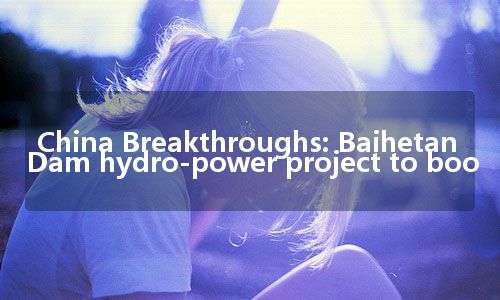Over half of the world's largest dams are located in China. As of 2015, China Electricity Council disclosed the country had 342 gigawatts (GW) of installed capacity, which accounts for about 15 percent of total energy consumption nationwide.

Energy experts believe China's current exploitable hydroelectric resources can reach 378GW, which is equivalent to annual power supply of 1.92 trillion kilowatt hours (kWh).
The world's largest hydro-power plant is the Three Gorges Dam in Sichuan Province on the Yangtze River, which was completed in July 2012 with 34 generators, fully-operational, and installed capacity - 22.7 GW.
Additionally, construction on the world’s second-largest hydro-power plant at Baihetan Dam had just started on August 3, 2017.
(Baihetan Dam hydro-power plant under construction Photo from Xinhua)
Baihetan Dam under construction
Lu Chun, Chairman of China Three Gorges Corporation announced at the opening ceremony that the plant is scheduled to begin delivering power in 2021 and go fully-operational by 2022.
Baihetan Dam is located - downstream Jinsha River that flows from the upper section - Yangtze River in Ningnan County, southwestern China’s Sichuan Province and borders Yunnan Province.
Beijing officials say Baihetan Dam could generate total installed hydro-power capacity 16 GW, accounting for 60 billion kWh/year, which would be equivalent to 2/3’s of Beijing’s electricity consumption in 2015.
The dam will stand nearly 300 meters high hovering above 91 percent of Jinsha River’s basin area; 430,000-sq./km. Approximately 100,000 residents from Sichuan and Yunnan have been relocated.
Yangtze River Economic Belt
Southwestern China offers an ideal setting for hydro-power generation, since many rivers flow at 2000-meters (m.) above sea level. The mountains soar high, meaning the river waters run deep and fast, and head eastward into the Yangtze River.
The Three Gorges Dam alone provides electricity for households in nine surrounding provinces and two major cities, including Shanghai. Baihetan Dam is expected to generate sufficient electricity for all residents in Sichuan and Yunnan Provinces.
Businesses along the Yangtze River will become the main beneficiaries. Most hydro-power plants in the country are connected to Yangtze River, such as Xiluodu (12,600 MW), Xiangjiaba (6000 MW), Longtan (6300 MW), Jinping I & II (8400 MW), Xiaowan (4200 MW), Laxiwa (4200 MW), Pubugou (3600 MW), Dagangshan (3600 MW) and Goupitan (3000 MW).
West-to-East transmission grid
Hydro-power offers other benefits for the public, such as no carbon dioxide emissions and can reduce China's reliance on coal, along with oil & gas imports.
"While China is currently still relying on fossil fuels, clean energy and renewable energy utilization will be an important direction for China’s energy consumption in the future," Wang Hao, academic at Chinese Academy of Engineering (CAE), told China Daily.
Wang added, "Hydro-power development in the upper reaches of Yangtze River still has a lot of potential to be further tapped."
Wang highlighted Beijing's strategy to build a West-to-East transmission grid that would allow the country to extract natural resources from the Western region and boost power to urbanized Eastern parts of the nation.
Beijing has set a nationwide goal for around 380 GW total installed hydro-power capacity by 2020.
Cutting back on pollution
When fully-operational, Baihetan Dam will not only supply power to the East China Power Grid, Central China Power Grid and Southern China Power Grid, but cut carbon emissions.
Officials forecast annual reductions on emissions: 170,000-tons of sulfur dioxide, 150,000-tons of nitrogen oxide and 220,000-tons of dust, as reported by China Daily.
Electricity that is expected to be generated from Baihetan Dam would cut the use of 20 million tons of coal. Yet building the dam will be no easy task.
Before construction of the main site started, planners, engineers and construction workers had engaged in six years of preliminary work. They had built the foundation for the dam and excavated underground tunnels.
For exact figures: The maximum height of the dam will be 277-meters, crest elevation 827-m., crest width - 13-m. and bottom width - 72-m. 16 generating units will be installed to produce 1,000 MW each.
Running waters for strong economy
Baihetan Dam and other dams in China will serve mulit-purpose functions. When weather conditions are normal, such as average seasonal temperatures and precipitation, the dams will generate electricity at full capacity.
Nevertheless, southwestern China with mountains and valleys frequently faces varied and unexpected weather patterns. On some years, droughts strike the region while at other times floods can devastate the area.
Dams can either increase water supply for rivers in dry weather or decrease water currents during floods. Such actions can save lives and keep agriculture bountiful.
Nonetheless, constructing dams comes at a price. The Three Gorges Dam had cost over US$25 billion and Baihetan Dam will have a high price tag as well. But, the huge investment will create many new jobs and transform Southwest China’s development.
China’s western region stands rich in natural resources, but many locals continue to struggle amid poverty. By providing them with more reliable and cheap energy, residents and businesses can enjoy greater prosperity that will create a stronger and more sustainable development mode for all of China.